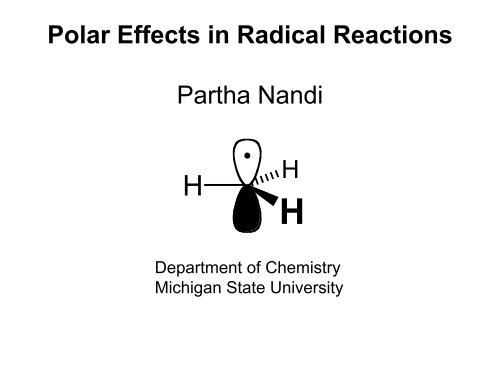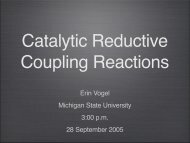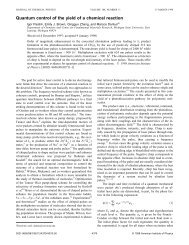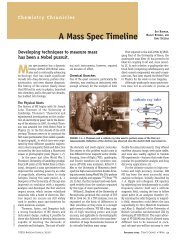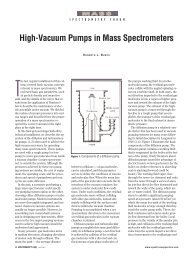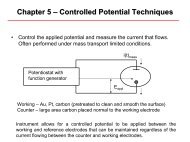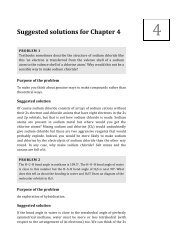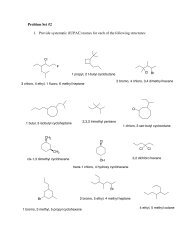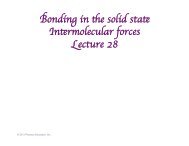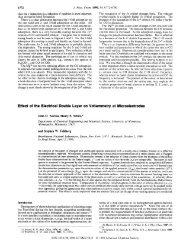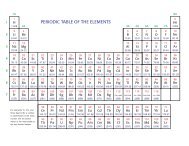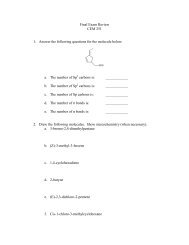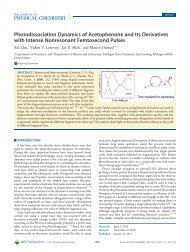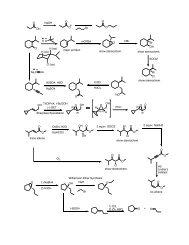Polar Effects in Radical Reactions - Department of Chemistry ...
Polar Effects in Radical Reactions - Department of Chemistry ...
Polar Effects in Radical Reactions - Department of Chemistry ...
You also want an ePaper? Increase the reach of your titles
YUMPU automatically turns print PDFs into web optimized ePapers that Google loves.
<strong>Polar</strong> <strong>Effects</strong> <strong>in</strong> <strong>Radical</strong> <strong>Reactions</strong><br />
Partha Nandi<br />
H<br />
H<br />
H<br />
<strong>Department</strong> <strong>of</strong> <strong>Chemistry</strong><br />
Michigan State University
Objectives and Motivations<br />
• Orig<strong>in</strong> <strong>of</strong> polar effects <strong>in</strong> organic radical reactions<br />
• Improve the ability to design experiments<br />
• F<strong>in</strong>d new ways to expand the scope <strong>of</strong> known reaction<br />
mechanisms to address reactivity-selectivity problems
Outl<strong>in</strong>e<br />
• The polar-effect <strong>in</strong> traditional organic reaction mechanisms.<br />
Is a polar-effect anticipated for radical reactions?<br />
• Factors responsible for polar-effect <strong>in</strong> radicals<br />
(1) Geometry and Orbital <strong>in</strong>teractions<br />
(2) Non-perfect synchronization <strong>of</strong> TS<br />
(3) Solvent polarity and viscosity (“cage effect”)<br />
• Specific examples and illustrations<br />
• Conclusions and remarks
Outl<strong>in</strong>e<br />
• <strong>Polar</strong>-effects <strong>in</strong> traditional organic reaction mechanisms<br />
Is a polar-effect anticipated for radical reactions?<br />
• Factors responsible for polar-effects <strong>in</strong> radicals<br />
(1) Geometry and Orbital <strong>in</strong>teraction effects<br />
(2) Non-perfect synchronization <strong>of</strong> TS<br />
(3) Solvent polarity and viscosity (“cage effect”)<br />
• Specific examples and illustrations<br />
• Conclusions and remarks
<strong>Polar</strong> <strong>Effects</strong> <strong>in</strong> Stereo-type Organic<br />
Reaction Mechanisms?<br />
R-X + Y(s) n<br />
TS1<br />
I. S N 1 Case II. S N 2 case<br />
R<br />
R (s) n<br />
TS2<br />
Less polar solvent<br />
More polar solvent<br />
R-Y + X(s) n<br />
R-X + Y(s) n<br />
X RY<br />
X<br />
Y<br />
More polar solvent<br />
Less polar solvent<br />
R-Y + X(s) n<br />
Same notion works for E1 and E2 mechanism<br />
“Theoretical and Physical Pr<strong>in</strong>ciples <strong>of</strong> Organic Reactivity”, Pross, A. John Wiley & Sons, Inc. 1996.
Summary <strong>of</strong> the Solvent <strong>Polar</strong>ity Effect<br />
Reaction Type<br />
R–X-->R +δ …X –δ<br />
Y+ R–X-->Y + δ …R…X –δ<br />
R–X +δ −−> R +δ …X –δ<br />
Y – + R–X--> Y – δ …R…X –δ<br />
Y – + R–X--> Y – δ …R…X +δ<br />
Nature <strong>of</strong><br />
Charge Type<br />
Separation<br />
Separation<br />
Dispersion<br />
Dispersion<br />
Annihilation<br />
Effect <strong>of</strong> polarity<br />
<strong>in</strong>crease on<br />
reaction rate<br />
Large Increase<br />
Large Increase<br />
Small Decrease<br />
Small Decrease<br />
Large Decrease<br />
“Theoretical and Physical Pr<strong>in</strong>ciples <strong>of</strong> Organic Reactivity”, Pross, A. John Wiley & Sons, Inc. 1996.
Outl<strong>in</strong>e<br />
• <strong>Polar</strong>-effects <strong>in</strong> traditional organic reaction mechanisms a<br />
brief overview. Is polar-effect anticipated for radical reactions<br />
• Factors responsible for polar-effects <strong>in</strong> radicals<br />
(1) Geometry and Orbital <strong>in</strong>teraction effects<br />
(2) Non-perfect synchronization <strong>of</strong> TS<br />
(3) Solvent polarity and viscosity (“cage effect”)<br />
• Specific examples and illustrations<br />
• Conclusions and remarks
Geometry and Orbital <strong>Polar</strong>ization:<br />
E<br />
H 3 M.O<br />
(Not to scale)<br />
Methyl <strong>Radical</strong><br />
π<br />
π∗ π∗<br />
σ*<br />
π<br />
nb<br />
σ<br />
MOs for Me<br />
2p z 2px 2p y<br />
C A.Os<br />
“Theoretical and Physical Pr<strong>in</strong>ciples <strong>of</strong> Organic Reactivity”, Pross, A. John Wiley & Sons, Inc. 1996.
Energy Changes on Pyramidalizations<br />
E<br />
CHF 2<br />
CH 3<br />
CF 3<br />
CH 2F<br />
0 4 8 12<br />
ω, degrees<br />
C<br />
α<br />
ω=α−90<br />
• ESR coupl<strong>in</strong>g<br />
• Computations<br />
• MO picture<br />
Zheng, X.; Phillips, D. L. J. Phys. Chem. A. 2000, 104, 1030.<br />
Cramer, C. J. J. Org. Chem., 1991, 56, 5229.<br />
Rozum, I.; Tennyson, J. J. Phys. B. 2004, 37, 957.<br />
• <strong>Polar</strong>ization proportional<br />
to dipole moment
MO for Pyramidalization<br />
C X<br />
X X<br />
SOMO - filled lone pairs repulsion<br />
pyramidalization helps to stabilize the SOMO<br />
by the <strong>in</strong>teraction <strong>of</strong> p-σ∗
Vibrational <strong>Polar</strong>ization & Pyramidalization<br />
• Geometrical flexibility <strong>of</strong> radicals can be rationalized<br />
from MO.<br />
• Vibrational polarizability<br />
E<br />
Vibrational polarization turn<strong>in</strong>g on<br />
Pyramidal <strong>in</strong>version<br />
“Solvation <strong>of</strong> the Methyl radical and Its implication” Stratt, R. M.; Desjard<strong>in</strong>s, S. G. J. Am. Chem.<br />
Soc. 1984, 106, 256.
E<br />
Role <strong>of</strong> Substituents on SOMO<br />
"C" centered<br />
SOMO<br />
n or filled<br />
σ orbital<br />
X type<br />
NR 2 , OR<br />
Cl, Me, I<br />
Z type<br />
COR, CN,<br />
SOR,<br />
NO, NO 2<br />
C type<br />
C=CH2<br />
Ph, etc<br />
“Orbital Interaction Theory <strong>in</strong> Organic <strong>Chemistry</strong>’” 2001, 2nd Ed, Rauk, A. Wiley & sons. Inc.,<br />
π∗<br />
π∗<br />
π
Outl<strong>in</strong>e<br />
•<strong>Polar</strong>-effects <strong>in</strong> traditional organic reaction mechanisms a<br />
brief overview. Is polar-effect anticipated for radical reactions?<br />
• Factors responsible for polar-effects <strong>in</strong> radicals<br />
(1) Geometry and Orbital <strong>in</strong>teraction effects<br />
(2) Non-perfect synchronization <strong>of</strong> TS<br />
(3) Solvent polarity and viscosity (“cage effect”)<br />
•Specific examples and illustrations<br />
•Conclusions and remarks
Hammond’s Postulate and Limitations<br />
E<br />
• Hammond’s postulate - what does it tell us?<br />
R<br />
RC<br />
P<br />
R'<br />
P'<br />
• Instant idea on nature <strong>of</strong> TS<br />
• Fails to give an accurate location <strong>of</strong> TS<br />
• Does not consider multiple degrees <strong>of</strong> freedoms<br />
along the reaction coord<strong>in</strong>ate<br />
• Modern version and extension <strong>of</strong> Hammond’s postulate - “The<br />
Pr<strong>in</strong>ciple <strong>of</strong> Nonperfect Synchronization”<br />
Bernasconi, C. F. Acc. Chem. Res. 1992, 25, 9.
Nonperfect Synchronization<br />
• ------- hypothetical resonance<br />
developments synchronous with<br />
charge transfer<br />
• ____ actual situation where<br />
resonance development lags beh<strong>in</strong>d<br />
charge transfer<br />
• Smaller degree <strong>of</strong> resonance<br />
stabilization <strong>of</strong> TS leads to a higher<br />
barrier<br />
“The Pr<strong>in</strong>ciple <strong>of</strong> Nonperfect Synchronization: More than a qualitative concept?”<br />
Bernasconi, C. F. Acc. Chem. Res. 1992, 25, 9.
“Nonperfect Synchronization” &<br />
“Imperfect TS”<br />
• Reaction potential energy surface is multi-dimensional<br />
• Bond break<strong>in</strong>g and formation<br />
• Solvation and desolvation<br />
• Delocalization and localization <strong>of</strong> charge<br />
• Unequal progress at the TS, termed as “Imperfect TS”<br />
“The Pr<strong>in</strong>ciple <strong>of</strong> Nonperfect Synchronization: More than a qualitative concept ?” Bernasconi, C. F.<br />
Acc. Chem. Res. 1992, 25, 9.
Outl<strong>in</strong>e<br />
• <strong>Polar</strong>-effects <strong>in</strong> traditional organic reaction mechanisms a<br />
brief overview. Is polar-effect anticipated for radical reactions?<br />
• Factors responsible for polar-effects <strong>in</strong> radicals<br />
(1) Geometry and Orbital <strong>in</strong>teraction effects<br />
(2) Non-perfect Synchronization <strong>of</strong> TS<br />
(3) Viscosity (“cage effect”) and solvent polarity<br />
• Specific examples and illustrations<br />
• Conclusions and remarks
6.5<br />
k disp/ kdim<br />
5.5<br />
5<br />
0<br />
R + R<br />
Viscosity <strong>Effects</strong><br />
Fate <strong>of</strong> diffusive cage pair<br />
k diff<br />
k -diff<br />
for t- Bu<br />
radical<br />
for 2-Propyl radical<br />
1 η (cP)<br />
2 3<br />
k dim<br />
( R/R ) cage<br />
k disp<br />
R-R<br />
R -H + R-H<br />
•Variation <strong>of</strong> k disp/k dim with viscosity<br />
•Shape matters: t- Bu radical an ellipsoid,<br />
isopropyl “V” shaped<br />
•Similar trend observed for polar radical<br />
reactions<br />
Shuch, H. H.; Fischer, H. Helv. Chim. Acta 1978, 61, 2463.<br />
M<strong>in</strong>isci, F.; Vismara, E.; Fontana, F.; Mor<strong>in</strong>i, G.; Serravalle, M.; Giordano, C. J. Org. Chem. 1987, 52, 730.
<strong>Polar</strong> Solvent Decelerat<strong>in</strong>g the Rate<br />
N<br />
O<br />
TEMPO<br />
Entry<br />
1.<br />
2.<br />
3.<br />
4.<br />
5.<br />
6.<br />
+<br />
CH 2<br />
Solvent<br />
Solvent<br />
n-pentane<br />
Cyclohexane<br />
Benzene<br />
Chlorobenzene<br />
Tetrahydr<strong>of</strong>uran<br />
Acetonitrile<br />
N<br />
O<br />
k T X 10 -7 , M -1 s -1<br />
50 + 1.5<br />
41 ± 2<br />
18 + 1<br />
17 + 2<br />
23 + 3<br />
9.5 + 0.7<br />
Beckwith, A. L. J.; Bowry, V. W.; Ingold, K. U J. Am. Chem. Soc. 1992, 114, 4983.
Outl<strong>in</strong>e<br />
• <strong>Polar</strong>-effects <strong>in</strong> traditional organic reaction mechanisms a<br />
brief overview. How do we th<strong>in</strong>k about radicals?<br />
• Factors responsible for polar-effects <strong>in</strong> radicals<br />
(1) Solvent polarity effects<br />
(2) Internal pressure and viscosity (“cage effect”)<br />
(3) Non-perfect synchronization <strong>of</strong> TS<br />
(4) Geometry and Orbital polarization<br />
• Specific examples and illustrations<br />
• Conclusions and remarks
Early Examples <strong>of</strong> <strong>Polar</strong> <strong>Radical</strong> <strong>Reactions</strong><br />
+ Br 2<br />
hv<br />
CH2 H Br<br />
δ− δ+<br />
Kim, S. S.; Choi, S. Y.; Kang, C. H. J. Am. Chem. Soc. 1985, 107, 4234.<br />
O<br />
R C<br />
heat<br />
O<br />
O O R C O<br />
OC(Me) 3<br />
R + CO2 + tBuO<br />
Barlett, P. D.; Hiatt, R. R. J. Am. Chem. Soc. 1958, 80, 1398.<br />
Br
Specific Examples and Illustrations<br />
(1) NO catalyzed oxidations<br />
(2) MGM, ICM and MCM catalyzed isomerizations<br />
(3) Silyl enol ether mediated 5-exo and 6-endo cyclizations,<br />
and general approach to 4-allyl oxyl radical cyclizations
Aerobic Oxidation <strong>of</strong> Benzyl Alcohols<br />
O<br />
N<br />
O<br />
PhCHOH<br />
O 2<br />
by NHPI or PINO<br />
O + H-CHOHPh<br />
N<br />
PhCH(OOH)OH<br />
PhCHO<br />
O<br />
O<br />
– δ + δ<br />
O H CHOHPh<br />
– OH<br />
PhCH(O)OH<br />
H atom abstraction<br />
-H 2O<br />
PhCH(OH) 2<br />
-PhCHOH<br />
M<strong>in</strong>isci, F.; Punta, C.; Recupero, F.; Fontana, F.; Pedulli, G. F. J. Org. Chem. 2002, 67, 2671.<br />
Annunziat<strong>in</strong>i, C.; Ger<strong>in</strong>i, M. F.; Lanzalunga, O.; Lucar<strong>in</strong>i, M. J. Org. Chem. 2004, 69, 3431.<br />
O<br />
N<br />
O<br />
O H
R 2<br />
Structural Modifications <strong>in</strong> PINO<br />
R 1<br />
R 3<br />
PINO<br />
O<br />
O<br />
N<br />
O<br />
Entry<br />
1<br />
2<br />
3<br />
4<br />
5<br />
HO<br />
+<br />
R 1<br />
H<br />
F<br />
H<br />
MeO<br />
MeO<br />
R 2<br />
MeO<br />
R 2<br />
MeOCO<br />
H<br />
H<br />
H<br />
R 1<br />
R 3<br />
NHPI<br />
R 3<br />
H<br />
H<br />
H<br />
H<br />
H<br />
O<br />
O<br />
N<br />
OH<br />
ρ<br />
+<br />
-0.70<br />
-0.69<br />
-0.68<br />
-0.60<br />
-0.54<br />
Annunziat<strong>in</strong>i, C.; Ger<strong>in</strong>i, M. F.; Lanzalunga, O.; Lucar<strong>in</strong>i, M. J. Org. Chem. 2004, 69, 3431.<br />
HO
Electronic Perturbation & Implications<br />
log(k x/k H)<br />
1.0<br />
0.8<br />
0.6<br />
0.4<br />
0.2<br />
0.0<br />
-0.2<br />
p-OMe<br />
p-Me<br />
m-Me<br />
p-Cl<br />
m-OMe<br />
m-CN<br />
m-Cl<br />
p-CN<br />
p-NO 2<br />
m-NO 2<br />
-0.4<br />
-0.9 -0.5<br />
σ<br />
-0.1 0.3 0.7<br />
+<br />
X<br />
OH<br />
PINO<br />
O<br />
Hammet plot where<br />
ρ= – 0.69<br />
M<strong>in</strong>isci, F.; Recupero, F.; Cecchetto, A.; Gambarotti, C.; Punta, C.; Faletti, R.; Paganelli, R.;<br />
Padulli, G. Eur. J. Org. Chem. 2004, 109.<br />
X<br />
H
Barrier Height for H Atom Abstraction<br />
O<br />
N<br />
O<br />
O + H-CHOHPh<br />
N<br />
>NO radical<br />
H 2 NO<br />
(O=CH)NHO<br />
(O=CH)N(CH 3 ) O<br />
(O=CH) 2 NO<br />
O<br />
O<br />
B3LYP/<br />
6-31G (kJ mol -1 )<br />
103<br />
78<br />
83<br />
49<br />
– δ + δ<br />
O H CHOHPh<br />
B3LYP/<br />
6-311++G<br />
109<br />
79<br />
86<br />
49<br />
-PhCHOH<br />
115<br />
92<br />
92<br />
66<br />
O<br />
N<br />
O<br />
CCSD (T)ccpVDZ/B3LY<br />
P/6-311++G<br />
Hermans, I.; Vereecken, P. A.; Jacobs, A.; Peters, J. Chem. Commun., 2004, 1140.<br />
O H
Potential Energy Surface Topology<br />
E<br />
30<br />
20<br />
10<br />
0<br />
-10<br />
-20<br />
-30<br />
-40<br />
ZPE corrected Energy<br />
( kJmol -1 )<br />
>NOH + CH 3OO<br />
Pre-reaction complex<br />
TS/Saddle po<strong>in</strong>t<br />
Reaction Co-ord<strong>in</strong>ate<br />
Post reaction complex<br />
(O=CH) 2 NO<br />
>NO + CH 3OOH<br />
Hermans, I.; Vereecken, P. A.; Jacobs, A.; Peters, J. Chem. Commun., 2004, 1140.
MO Picture for H Atom Abstraction<br />
B B H-A<br />
Energy (Not to scale)<br />
H-A<br />
B H A<br />
B-H<br />
B-H A<br />
“The stability <strong>of</strong> alkyl radicals”, Tsang, W. J. Am. Chem. Soc., 1985, 107, 2872.<br />
“K<strong>in</strong>etics and Thermochemistry <strong>of</strong> CH 3 , C 2 H 5 , i- C 3 H 7 , Study <strong>of</strong> equilibrium <strong>of</strong> R + HBr”<br />
Russel, J. J.; Seetula, J. A.; Gutman, D. J. Am. Chem. Soc., 1990, 112, 1347.<br />
A
N<br />
OH<br />
69.6<br />
Enthalpy Effect<br />
N<br />
OH<br />
O<br />
79.2 88.1<br />
O-H Bond Dissociation<br />
Energy (kcal/mol)<br />
M<strong>in</strong>isci, F.; Recupero, F.; Cecchetto, A.; Gambarotti, C.; Punta, C.; Faletti, R.;<br />
Paganelli, R.; Padulli, G. Eur. J. Org. Chem. 2004, 109-119.<br />
O<br />
N<br />
O<br />
OH
Fundamental Steps <strong>of</strong> TEMPO Catalyzed<br />
2<br />
R<br />
R<br />
N<br />
O<br />
R H + O X R + HOX<br />
N<br />
OH<br />
N<br />
O<br />
N<br />
O<br />
O 2<br />
R<br />
R<br />
N<br />
Mn(II), Co(II)<br />
H<br />
Oxidations<br />
OH<br />
O R O O R O O<br />
N<br />
O<br />
N<br />
O<br />
N<br />
O<br />
+<br />
O + H +<br />
M<strong>in</strong>isci, F.; Recupero, F.; Cecchetto, A.; Gambarotti, C.; Punta, C.; Faletti, R.; Paganelli, R.; Padulli, G.<br />
Eur. J. Org. Chem. 2004, 109-119.<br />
R<br />
N<br />
OH<br />
N<br />
OH<br />
N<br />
OR
<strong>Polar</strong> Non-radical Mechanism?<br />
N<br />
O<br />
N<br />
O<br />
+ H<br />
OH<br />
+ H<br />
OH<br />
B<br />
-H<br />
N<br />
HO O<br />
N<br />
O O<br />
H<br />
-BH<br />
H B<br />
N<br />
OH<br />
N<br />
OH<br />
+ O<br />
+ O<br />
M<strong>in</strong>isci, F.; Recupero, F.; Cecchetto, A.; Gambarotti, C.; Punta, C.; Faletti, R.; Paganelli, R.; Padulli, G.<br />
Eur. J. Org. Chem. 2004, 109-119.
Specific Examples and Illustrations<br />
(1) NO catalyzed oxidations<br />
(2) MGM, MCM and ICM catalyzed isomerization<br />
(3) Silyl enol ether mediated 5-exo and 6-endo cyclizations,<br />
and general approach to 4-allyl-oxyl radical cyclizations.
<strong>Polar</strong> <strong>Radical</strong> Pathway <strong>of</strong> MGM<br />
HOOC<br />
COOH<br />
2-methyleneglutaric acid<br />
XOOC<br />
COOX<br />
X = H / R /<br />
MGM or<br />
Methyleneglutarate-mutase<br />
XO 2C<br />
CO 2X<br />
HOOC<br />
COOH<br />
3-methylitaconic acid<br />
XOOC<br />
Newcomb, M; Miranda, N. J. Am. Chem. Soc. 2003, 125, 4080.<br />
COOX
Potential Energy Pr<strong>of</strong>ile Analysis<br />
Energy (kcal/mol)<br />
HOOC<br />
Reactant<br />
12.1<br />
COOH<br />
HO 2C<br />
12.1<br />
CO 2H<br />
Reaction Co-ord<strong>in</strong>ate<br />
Tri-radical <strong>in</strong>termediate<br />
8.6<br />
12.1<br />
Newcomb, M; Miranda, N. J. Am. Chem. Soc. 2003, 125, 4080.<br />
HOOC<br />
COOH
Apparent Paradox <strong>in</strong> MGM Catalyzed<br />
Isomerization<br />
• Rate Constant for cyclization estimated to be 2000 s -1<br />
• Estimation is coupled with partion<strong>in</strong>g <strong>of</strong> <strong>in</strong>termediate cyclopropyl<br />
carb<strong>in</strong>yl radical, overall rate constant is estimated to be 10E-3 s -1 ,<br />
• Unusual mechanism is possibly <strong>in</strong>volved with polar effects operative<br />
HO 2C<br />
O 2C<br />
Scheme A:<br />
Scheme B:<br />
CO 2H<br />
CO 2<br />
HO 2C<br />
O 2C<br />
CO 2H<br />
CO 2<br />
HO 2C<br />
O 2C<br />
CO 2H<br />
CO 2<br />
Newcomb, M; Miranda, N. J. Am. Chem. Soc. 2003, 125, 4080.
Catalytic Mechanism Devoid <strong>of</strong> 3-exo<br />
O 2C<br />
O 2C<br />
H<br />
H<br />
CO 2<br />
H<br />
CO 2<br />
Cyclization<br />
Methylene-glutarate-Mutase<br />
O 2C<br />
H<br />
CO 2<br />
H<br />
H<br />
O 2C<br />
O 2C<br />
H<br />
H<br />
H<br />
• Fragmentation results formation <strong>of</strong> a radical that is stabilized by a<br />
through space polar-captodative orbital <strong>in</strong>teractions.<br />
H<br />
H<br />
CO 2<br />
CO 2
Solvent <strong>Polar</strong>ity Effect and Limited<br />
G<br />
Ph<br />
Ph<br />
Ph<br />
O<br />
S<br />
Acid Catalysis<br />
CoA G O<br />
S CoA G S CoA<br />
G= CO 2H (MCM catalyzed rearrangement)<br />
G=CH 3 (Isobutyryl CoA Mutase catalyzed rearrangement)<br />
PhSe<br />
Ph<br />
O<br />
X=H/Me/SEt<br />
X<br />
X<br />
hv<br />
O<br />
Bu 3SnH<br />
Ph<br />
Ph<br />
O<br />
Ph X<br />
Ph<br />
Daubla<strong>in</strong>, P.; Horner, J. H.; Kuznetsov, A.; Newcomb, M. J. Am. Chem. Soc. 2004, 126, 5368.<br />
X<br />
O<br />
Ph<br />
Ph<br />
Ph<br />
Ph<br />
O<br />
O<br />
X<br />
X<br />
O
Solvent <strong>Polar</strong>ity and Acid Catalysis<br />
logk<br />
11<br />
9<br />
7<br />
5<br />
CF 3CH 2OH<br />
MeCN<br />
CH 2Cl 2<br />
THF<br />
Cyclohexane<br />
Gasphase<br />
E T (30)<br />
AcOH<br />
30 40 50 60 70 80<br />
k obs X 10 -6<br />
TFA(M)<br />
CH 2Cl 2<br />
Hexane<br />
A: Observed rate constant for reaction <strong>of</strong> 1st <strong>in</strong>termediate<br />
B: Rate constant <strong>of</strong> reactions <strong>of</strong> 1st <strong>in</strong>termediate <strong>in</strong> presence <strong>of</strong><br />
TFA <strong>in</strong> CH 2 Cl 2 and <strong>in</strong> hexane<br />
Daubla<strong>in</strong>, P.; Horner, J. H.; Kuznetsov, A.; Newcomb, M. J. Am. Chem. Soc. 2004, 126, 5368.
“Partial Protonated” radical<br />
Ph<br />
Ph<br />
O<br />
H O<br />
X<br />
O<br />
CF 3<br />
H 2N CH C<br />
N<br />
CH 2<br />
NH<br />
O<br />
Histid<strong>in</strong>e<br />
• Catalytic role <strong>of</strong> His244 <strong>in</strong> the catalytic site <strong>of</strong> MCM catalyzed reaction<br />
• Mechanistic reconsiderations - Role <strong>of</strong> surround<strong>in</strong>g water <strong>in</strong> nucleophilic<br />
assistance<br />
G<br />
Nu OX<br />
S<br />
X= or H<br />
CoA<br />
G Nu<br />
+<br />
OX<br />
CoA<br />
S<br />
Nu OX<br />
OH<br />
G SCoA<br />
Daubla<strong>in</strong>, P.; Horner, J. H.; Kuznetsov, A.; Newcomb, M. J. Am. Chem. Soc. 2004, 126, 5368.
Specific Examples and Illustrations<br />
(1) NO catalyzed oxidations<br />
(2) MGM catalyzed isomerization<br />
(3) Silyl enol ether mediated 5-exo and 6-endo cyclizations,<br />
and general approach to 4-allyl-oxyl radical cyclizations
Cyclization <strong>of</strong> Silyl-enol Ether <strong>Radical</strong><br />
Cations<br />
OTBDMS OTBDMS<br />
O<br />
O<br />
I<br />
hv<br />
hv, AIBN<br />
6-endo<br />
O O<br />
6-endo<br />
Bunte, J. O.; Heilmann, E. K.; He<strong>in</strong>, B.; Mattay, J.; Eur. J. Org. Chem. 2004, 3535.<br />
Curran, D. P.; Chang, C. T.; J. Org. Chem. 1989, 54, 3140.<br />
+<br />
O<br />
5-exo
Selectivity <strong>in</strong> 5-exo or 6-endo <strong>Radical</strong><br />
Cyclization<br />
Process<br />
Rate Constant<br />
5-exo<br />
2.0E-6<br />
+<br />
6-endo<br />
2.6E-6<br />
• No apparent preference <strong>in</strong> the formation <strong>of</strong> a tertiary vs a<br />
primary radical<br />
• Can be expla<strong>in</strong>ed <strong>in</strong> terms <strong>of</strong> assum<strong>in</strong>g 5-exo process<br />
reversible, besides suitable thermodynamics<br />
Bunte, J. O.; Heilmann, E. K.; He<strong>in</strong>, B.; Mattay, J.; Eur. J. Org. Chem. 2004, 3535.
Steps Involved <strong>in</strong> photo-cylization <strong>of</strong><br />
silyl-enol ether<br />
SiR3 SiR<br />
O O 3 Nu<br />
hv<br />
-e<br />
O<br />
Mesolytic<br />
Si–O cleavage<br />
H atom abstraction<br />
O<br />
O<br />
6-endo<br />
cyclization<br />
Bunte, J. O.; Heilmann, E. K.; He<strong>in</strong>, B.; Mattay, J.; Eur. J. Org. Chem. 2004, 3535.
Geometrical Changes Induced by One<br />
Electron Oxidation<br />
O Si<br />
-e<br />
d(C-C):1.42(+0.08) A<br />
O Si<br />
a(O-Si-C):100.8(-8.2)<br />
d(C-O):1.28(-0.08) A<br />
d(Si-O):1.80(+0.11) A<br />
o<br />
o<br />
o<br />
a(C-O-Si):136.1(+8.4)<br />
• Weakened Si-O bond leads to a facile S N2- like substitution<br />
<strong>in</strong>duced by solvent or other nucleophile<br />
Bunte, J. O.; Heilmann, E. K.; He<strong>in</strong>, B.; Mattay, J.; Eur. J. Org. Chem. 2004, 3535.
Selectivities <strong>in</strong> Five vs Six-membered<br />
Photo-cyclizations <strong>of</strong> Silyl-enol Ethers<br />
Case I<br />
Case II<br />
H<br />
+<br />
H + H<br />
OTMS H<br />
O O<br />
H<br />
H H<br />
H O<br />
OTMS<br />
31%<br />
41% 28%<br />
H + H<br />
H<br />
H<br />
H<br />
O H O<br />
90% 10%<br />
Bunte, J. O.; Heilmann, E. K.; He<strong>in</strong>, B.; Mattay, J.; Eur. J. Org. Chem. 2004, 3535.
Calculated Energy Pr<strong>of</strong>ile for Case I<br />
Energy<br />
kcal/mol<br />
H<br />
+<br />
H + H<br />
OTMS H<br />
O O<br />
H<br />
H H<br />
H O<br />
H O<br />
NOT TO SCALE<br />
-1.15<br />
+21-25<br />
+19.72<br />
H O<br />
-2.49<br />
0.0<br />
O<br />
0.0<br />
+21-25<br />
+17.9<br />
H H O<br />
-8.39<br />
-9.40<br />
Bunte, J. O.; Heilmann, E. K.; He<strong>in</strong>, B.; Mattay, J.; Eur. J. Org. Chem. 2004, 3535.<br />
H<br />
H<br />
O
Potential Energy Pr<strong>of</strong>ile for Case II<br />
Energy<br />
H<br />
O<br />
OTMS<br />
25<br />
2.79 2.79<br />
H<br />
O<br />
Numbers <strong>in</strong> kcal/mol<br />
H + H<br />
22<br />
H<br />
H<br />
H<br />
O H O<br />
O<br />
-7.46<br />
19<br />
0.0<br />
23.5<br />
-6.16<br />
H<br />
H O<br />
O<br />
H<br />
H<br />
Bunte, J. O.; Heilmann, E. K.; He<strong>in</strong>, B.; Mattay, J.; Eur. J. Org. Chem. 2004, 3535.
How General Are These 5-exo vs<br />
R 1 ,<br />
H H<br />
H Me<br />
H C(Me) 3<br />
H<br />
Ph<br />
Me H<br />
R 2<br />
Me Me<br />
R1<br />
Me C(Me) 3<br />
6-endo Selectivities?<br />
O Me<br />
R 2<br />
5-exo<br />
5-exo/6-endo<br />
98/2<br />
69/31<br />
46/54<br />
7/93<br />
98/2<br />
82/18<br />
37/63<br />
R 1<br />
O<br />
R 2<br />
H-Y<br />
Y H-Y Y<br />
R 1<br />
• Substituents that <strong>in</strong>crease <strong>in</strong> HOMO<br />
coefficient along C-5 lead to more 6endo<br />
product<br />
• Substituents that can not cause the<br />
<strong>in</strong>crease <strong>in</strong> C-5 HOMO coefficient lead to<br />
more 5-exo product<br />
O<br />
H<br />
6-endo<br />
Hartung, J.; Kneuer, R.; Rummey, C.; Br<strong>in</strong>gmann, G. J. Am. Chem. Soc. 2004, 126, 12121.<br />
R 2
O<br />
Reaction Model for Analysis<br />
R 2<br />
alkoxy radical<br />
R<br />
O<br />
2 O<br />
R2 5-exo-chair<br />
R 2<br />
R<br />
O<br />
2<br />
R 2<br />
5-exo-boat<br />
O<br />
6-endo-chair<br />
O<br />
6-endo-boat<br />
R 2<br />
R 2<br />
R 2<br />
O<br />
O<br />
O<br />
O R 2<br />
Start<strong>in</strong>g geometry TS cyclized radical<br />
Hartung, J.; Kneuer, R.; Rummey, C.; Br<strong>in</strong>gmann, G. J. Am. Chem. Soc. 2004, 126, 12121.<br />
O<br />
R 2
Ph<br />
Cl<br />
Ph<br />
Cl<br />
Ph<br />
Cl<br />
A True Ion or A <strong>Polar</strong> <strong>Radical</strong> ?<br />
δ+ δ−<br />
Cl CCl3 Cl CCl 3<br />
CCl 4<br />
Ph<br />
Cl<br />
Cl<br />
Cl<br />
Ph<br />
Ph<br />
+<br />
Cl<br />
Cl<br />
hv Cl<br />
N<br />
N Ph<br />
Dimerizations<br />
Ph<br />
Ph<br />
Cl<br />
Ph<br />
Cl CCl 3<br />
Cl Cl<br />
Ph<br />
CCl 4<br />
Ph<br />
Cl Cl<br />
Ph<br />
+ CCl3 Cl Cl<br />
Cl Cl<br />
+<br />
Ph<br />
Cl<br />
Cl Cl<br />
Ph<br />
Cl Cl<br />
Cl<br />
+<br />
Cl<br />
Cl<br />
Cl<br />
Cl Cl<br />
- <strong>Polar</strong> atom transfer<br />
-Ylide<br />
- Dissociative electron<br />
transfer<br />
Jones, M. B.; Jackson, J. E.; Soundararajan, N.; Platz, M. S. J. Am. Chem. Soc. 1988, 110, 5597.
Ph<br />
Cl Cl CCl3 Ph<br />
Cl Cl CCl3 Ph<br />
Cl<br />
δ+ δ-<br />
CCl 4<br />
Ph<br />
Cl Cl CCl 3<br />
Substitut<strong>in</strong>g Cl by CN:<br />
1<br />
3<br />
2<br />
Answer<br />
Ph<br />
Cl Cl<br />
carbene<br />
PhCCl<br />
PhCCl<br />
PhCCl<br />
PhCCl<br />
(pOMe)-<br />
PhCCl<br />
Cl donor<br />
CCl 4<br />
CCl 3 CN<br />
CCl 2 (CN) 2<br />
CCl 3 CN<br />
CCl 3 CN<br />
• Expected to retard the rate for ylide mechanism (2)<br />
• Accelerate the rate for polar atom transfer (1 & 3)<br />
solvent<br />
MeCN<br />
PhMe<br />
PhMe<br />
MeCN<br />
PhMe<br />
k (M -1 s -1 )<br />
3.8E4<br />
1.4E7<br />
8.4E8<br />
4.0E8<br />
1.1E8<br />
Jones, M. B.; Jackson, J. E.; Soundararajan, N.; Platz, M. S. J. Am. Chem. Soc. 1988, 110, 5597.<br />
Jones, M. B.; Maloney, V. M.; Platz, M. S. J. Am. Chem. Soc. 1992, 114, 2163.
Conclusions & Remarks<br />
1. <strong>Polar</strong> effect <strong>in</strong> radical reactions orig<strong>in</strong>ates from a polar TS that is <strong>of</strong>ten<br />
achieved through, electronic perturbation (from Orbital <strong>in</strong>teractions,<br />
medium polarity etc) Geometrical changes and Nonperfect<br />
synchronization (NPS)<br />
2. NO catalyzed oxidations, MGM, MCM and ICM catalyzed isomerizations,<br />
and radical cyclizations were shown as representative examples where<br />
polar effects were found to be operative<br />
3. Dist<strong>in</strong>guish<strong>in</strong>g a polar radical TS and completely ionic TS can <strong>of</strong>ten be<br />
challeng<strong>in</strong>g<br />
4. Higher level computations can help <strong>in</strong> understand<strong>in</strong>g polar effects <strong>in</strong><br />
radical reactions
Diels-Alder Reaction <strong>in</strong> Water<br />
• Enhanced hydrophobic <strong>in</strong>teraction <strong>in</strong> the TS<br />
• Internal Pressure<br />
• Higher polarizability <strong>of</strong> TS<br />
• Increased Endo selectivity<br />
• Problems <strong>of</strong> solubility & possible remedy by try<strong>in</strong>g<br />
cosolvents, constra<strong>in</strong>ed medium (zeolite, micellar<br />
medium etc).<br />
EDG<br />
EWG<br />
Bresslow, R.; Rideout, D. J. Am. Chem. Soc. 1980, 102, 7816.<br />
Otto, S.; Engberts, J. B. Pure Appl. Chem., 2000, 7, 1365.<br />
+<br />
EDG<br />
EWG
Acknowledgement<br />
1. Parents - Asim K Nandi & Parbati Nandi<br />
2. Dr. Jackson, Dr. Dye, Dr. Wagner, Dr. Wulff<br />
3. Michael (SiGNa)<br />
4. Labmates - Simona, Misha, Andrea, Jennifer,<br />
Tulika, Karrie, and Kaushik<br />
5. Friends - Sampa, Supriyo, Sanjukta, Aparajita,<br />
Sam, Parul, Bani, Brad<br />
6. Roommate - Neil
Typical Dipole-Moments <strong>of</strong> <strong>Radical</strong>s<br />
Species<br />
CH 3<br />
CF 3<br />
CH 3CH 2<br />
CH2CHCH2 CH2CHCHOH ClCH 2CHCH 3<br />
ClCHCHCH 2<br />
HCC<br />
N 3<br />
HOO<br />
http://www.colby.edu/chemistry/webmo/mo<strong>in</strong>tro.html<br />
Dipole Moments <strong>in</strong> Debye<br />
0.00141<br />
0.00615<br />
0.43937<br />
0.07868<br />
2.38577<br />
2.87736<br />
1.25684<br />
0.80287<br />
0.00103<br />
2.52010
Pyramidalization <strong>Effects</strong> on Energy<br />
and Dipole Moment<br />
QuickTime and a<br />
TIFF (LZW) decompressor<br />
are needed to see this picture.
Measure <strong>of</strong> Solvent <strong>Polar</strong>ity<br />
• Energy <strong>of</strong> charge transfer as a <strong>in</strong>tramolecular (E T ) or<br />
<strong>in</strong>termolecular (Z) process<br />
Ph<br />
Ph<br />
E T Scale<br />
Ph<br />
N<br />
O<br />
Ph<br />
Ph<br />
I<br />
COOCH 3<br />
N<br />
CH 2CH 3<br />
Z Scale<br />
hv<br />
Reichardt, C. Chem. Rev. 1994, 94, 2319.<br />
COOCH 3<br />
N<br />
CH 2CH 3<br />
I
Catalytic Mechanism <strong>of</strong> MCM Catalyzed<br />
Isomerization<br />
CoAS<br />
CoAS<br />
O<br />
O<br />
H H<br />
CO 2<br />
H<br />
CO 2<br />
CoAS<br />
CoAS<br />
H<br />
CO 2<br />
O<br />
CO 2<br />
H<br />
O<br />
CoAS<br />
H<br />
CoAS<br />
H<br />
H<br />
H<br />
H<br />
O<br />
O<br />
CO 2<br />
H<br />
CO 2<br />
H
MO <strong>of</strong> NO<br />
π∗ 2p<br />
π 2p<br />
E σ∗ 2s<br />
NO<br />
σ∗ 2p<br />
σ 2p<br />
σ 2s<br />
σ∗1s<br />
σ 1s<br />
π∗ 2p<br />
π 2p
NC<br />
Captodative <strong>Effects</strong><br />
OMe<br />
6<br />
CN<br />
12<br />
OMe<br />
16<br />
Barrier <strong>of</strong> C-C rotation <strong>in</strong> kcal/mol
Factors Responsible For the Selectivities<br />
• Rate constants for cyclizations<br />
• Life-time <strong>of</strong> the radical <strong>in</strong>termediates<br />
• Length <strong>of</strong> the new bond formed (Beckwith-Houk model)<br />
• Endothermicity or exothermicity<br />
• Steric or geometrical optimization<br />
Bunte, J. O.; Heilmann, E. K.; He<strong>in</strong>, B.; Mattay, J.; Eur. J. Org. Chem. 2004, 3535.
Calculated Charge and Sp<strong>in</strong> Distribution<br />
+0.29<br />
-0.05<br />
+0.18<br />
+0.17<br />
-0.04<br />
O Si<br />
TMS:+0.17<br />
0.03<br />
0.52<br />
0.03<br />
0.18<br />
0.03<br />
0.69<br />
0.03<br />
O Si O<br />
0.15 0.01<br />
0.20<br />
charge sp<strong>in</strong> sp<strong>in</strong><br />
Bunte, J. O.; Heilmann, E. K.; He<strong>in</strong>, B.; Mattay, J.; Eur. J. Org. Chem. 2004, 3535.<br />
0.05


